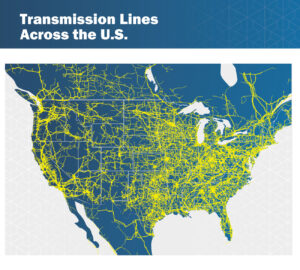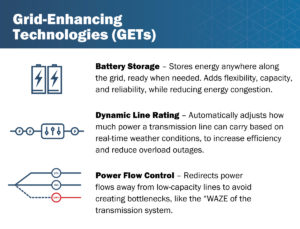ELPC Press Release

ELPC Receives American Bar Association's Award for Excellence
Learn MoreUtility-scale battery energy storage. Photo credit: Fluence

Smart technologies can make the most of existing transmission lines and relieve grid congestion faster and cheaper than wires-only solutions
In order to integrate renewables nationwide and reduce the worst impacts of climate change, we need a robust, efficient, and modern electricity delivery network.
Transmission lines already crisscross much of our country, but the current patchwork of high and low-capacity lines doesn’t always line up with where clean electricity is being generated or needed, causing overloaded transmission lines and wasted energy. We must improve the existing wires-based transmission system with smart technology to relieve energy congestion to ensure we can quickly and cost-effectively connect clean energy to the grid.
READ OUR REPORT: Moving Beyond Wires
Traditional transmission lines are expensive, time-consuming, and logistically difficult. The slow nature of traditional transmission construction has a disproportionate impact on clean energy projects, since they represent the majority of new generation projects getting built. The climate crisis requires us to move towards clean, renewable energy as quickly as possible. Advanced transmission technologies, such as battery storage, dynamic line rating, power flow control, and distributed energy solutions, can relieve congestion and get renewables onto the grid faster and cheaper than relying on new transmission lines alone.
“Grid enhancing technologies can do for the transmission system what smart meters did at the distribution level, but they aren’t being deployed because transmission developers have no incentive to use them.”
-Jon Wellinghoff, Former FERC Chairman
To be clear, this is not an “either/or” choice between traditional large wires projects and new grid-enhancing technologies. However, much of the US is already blanketed by underutilized transmission lines, while planners and transmission owners largely ignore lower-cost solutions that can help unclog existing transmission capacity. By embracing smart technologies in conjunction with transmission lines, the U.S. can reduce carbon pollution, protect the environment, limit costs, increase flexibility, create jobs, and promote transparency and competition.
The Beyond Wires Coalition works to ensure that transmission and distribution-connected technologies are fully considered and optimally deployed to maximize the cost-effective delivery of renewable electricity while maintaining reliability. ELPC is working with the Center for Renewables Integration (CRI) on this project, with feedback from Grid Policy, Inc. and other organizations, thought leaders, and businesses.
This work will require significant advocacy and participation at the federal, regional, and state levels, starting with these three areas of policy and legal intervention:
 Utilization – We will advocate for increased transparency and the development of utilization metrics to show how electricity is used throughout the grid on a more granular level. Regular and standardized transmission utilization studies will help identify opportunities for targeted non-wires solutions.
Utilization – We will advocate for increased transparency and the development of utilization metrics to show how electricity is used throughout the grid on a more granular level. Regular and standardized transmission utilization studies will help identify opportunities for targeted non-wires solutions.